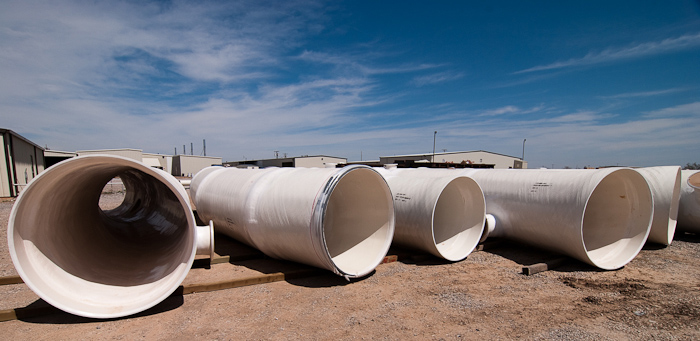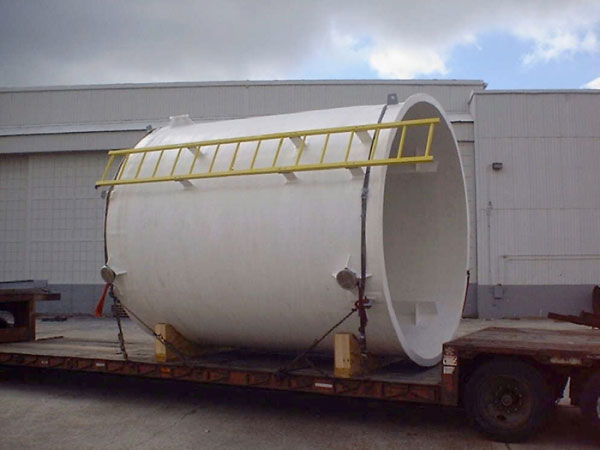The Storage of Sulfuric Acid in FRP Composite Tanks
Sulfuric acid (H2SO4) is a chemical that presents unique handling and storage problems. In the higher concentration ranges (96% to 97%), sulfuric acid (66Be’) can be stored in cast iron or carbon steel. High concentrations of sulphuric acid, however, are very detrimental to FRP composite equipment. At these higher concentrations, sulfuric acid must not come in contact with FRP laminates.
Diluted sulfuric acid, on the other hand, is very aggressive toward cast iron or steel tanks, but can be stored and handled very well in FRP composite equipment. FRP composite equipment is best suited for concentrations of 70% sulfuric acid and below. At 75% sulfuric acid, the maximum temperature allowed with vinyl ester resins is 100° to 120°F. As the concentration decreases, the allowable temperature limits increase.
The procedure for dilution of concentrated sulphuric acid that has worked best in fiberglass composite vessels is as follows:
1. First, add to the storage vessel the entire amount of water required to achieve the desired solution concentration.
2. Then add the concentrated acid slowly into the center of tank by using one of the following suggested fittings:
a) an FRP top nozzle with a PVC flanged down pipe.
b) a PVC coupling and down pipe.
c) a 316 stainless steel coupling with a 316 stainless steel down pipe. The reason the concentrated sulfuric acid is added to the tank center is to prevent concentrated acid from coming in contact with an FRP composite nozzle, or sidewalls of the tank. The concentrated acid should not be allowed to drop onto the liquid surface. Introduce the concentrated sulfuric acid 2” to 3” below the liquid surface. One method of accomplishing this is to create vortex by adding baffles from the bottom of the tank to the height that concentrated acid is first added to the tank. Another alternate method is to extend the down pipe 6” below
the liquid surface.
3. During the dilution process, the mixture must be continually agitated to insure adequate dilution and prevent high concentrations of sulfuric acid from settling and damaging the FRP composite tank. To insure adequate dilution, a rubber-coated agitator, or pumping the tank continuously through a side bottom drain,is required. Circulation through any nozzle on the tank bottom could result in heavy viscous concentrated acid settling to the tank bottom and destroying the FRP composite tank below the nozzle.
4. The dilution of sulfuric acid generates considerable amounts of heat. The temperature of the diluted sulfuric acid must be controlled below 150°F for finished concentrations of 50% or less, and 140°F for 50-70% sulfuric acid solutions. This can be accomplished by regulating the flow rate of concentrated sulfuric acid addition, or by external cooling of the tank contents.
5. The preferred type of FRP composite vessel for storing sulfuric acid is a non-insulated, vertical, above ground tank. Even underground tanks, with the ground acting as an insulator, may have excessive storage temperatures.
6. Sulfuric acid (H2SO4) with trace organic impurities can cause reduced service life of FRP composite laminates.
Contact us today about your fiberglass pipe and fiberglass tank requirements.


 Jack Mallinson of FMC Corporation’s plant in Front Royal, Virginia, working in conjunction with Beetle Plastics, then located in Fall River, Massachusetts, conducted some of the earliest work in improving abrasion resistance of
Jack Mallinson of FMC Corporation’s plant in Front Royal, Virginia, working in conjunction with Beetle Plastics, then located in Fall River, Massachusetts, conducted some of the earliest work in improving abrasion resistance of 
 In earlier posts, we discussed the first reason to choose lined FRP pipe:
In earlier posts, we discussed the first reason to choose lined FRP pipe:  It has always been our contention that all
It has always been our contention that all 








